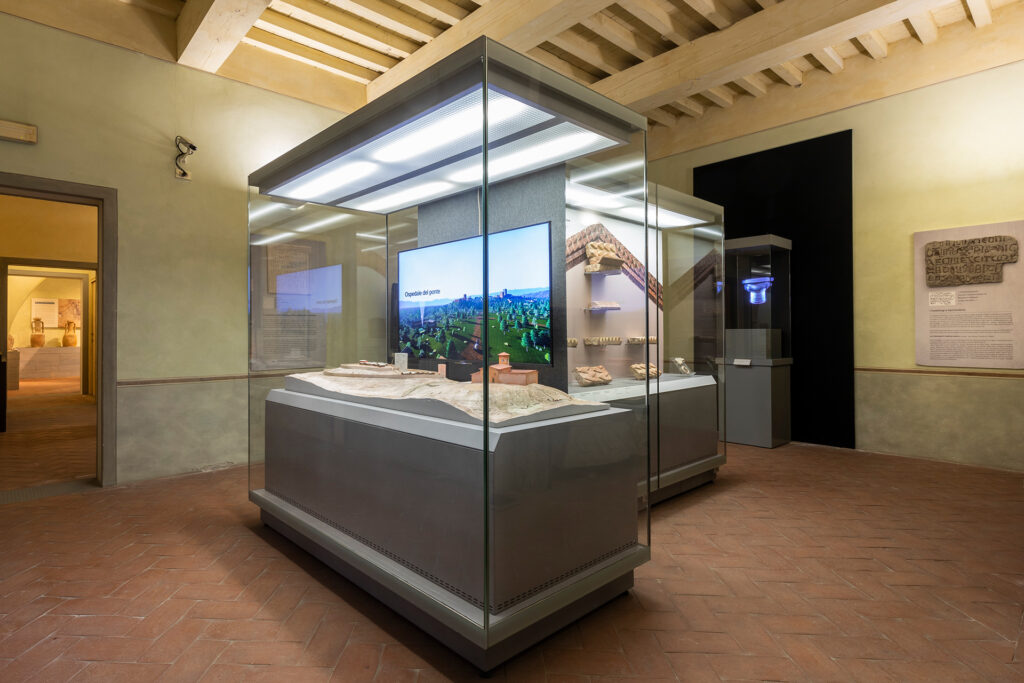- The Museum
- The Rooms
- Archaeology (1-6)
- Art (7-15)
- Room 7. Paintings, frescoes and Minor Guilds from the 13th to the 15th centuries
- Room 8. The great 16th-century paintings
- Room 9. 17th-century paintings
- Room 10. The jewellery room
- Room 11. 17th- and 18th-centuries paintings and jewellery
- Rooms 12-13. The sacred vestments
- Room 14. The relics of Giuseppe Montanelli (Fucecchio, 1813-1862)
- Room 15. The Arturo Checchi collection (Fucecchio 1886 – Perugia 1971)
- Nature (16-17)
- Collections
- Temporary exhibitions
- Events
- Multimedia
- Surroundings
- Versione italiana
Room 4. From the counts Cadolingi to the communal age
The room is dedicated to the foundation of the castle of Salamarzana and to the events that gave place to the castle of Fucecchio. The vast territorial lordship of the Cadolingi had its administrative center in the castle of Salamarzana, founded around 982 AD by Lotario, son of the progenitor Càdolo, at the point where the Via Romea crossed the Arno river. A few years later, the abbey of San Salvatore was built alongside the castle. This scheme was replicated, financed by the same family, further up the left bank of the river Arno, near Florence, with the castle of Montecascioli and the abbey of San Salvatore a Settimo. In addition to the display of the terracotta elements that decorated the top of the abbey church at the end of 1100 AD, in the room you can see gathered, for the first time in high definition 3D all the epigraphs produced for this family. The subsequent development of the Fucecchio castle is told in a video that reconstructs the appearance it had still in 1503, when Leonardo da Vinci drew it on the map of the lower Valdarno.
Further informations
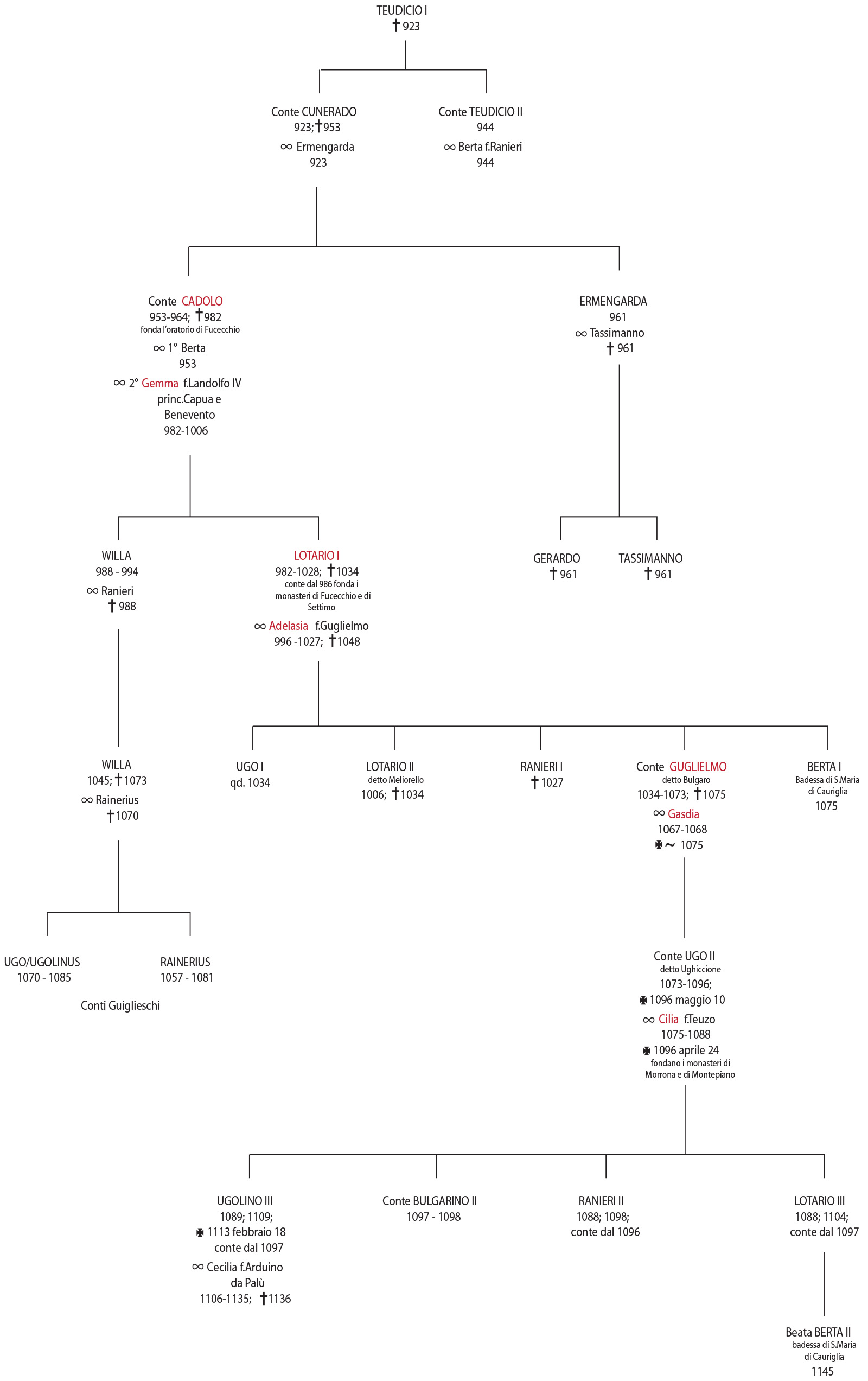
The Cadolingi family was one of the most prominent in Tuscany during the 10th-12th centuries. The family was of ancient lombard origin and the forefather, Càdolo, was appointed count in the town of Pistoia. Before the 10th century they moved toward the river Arno where they founded the castle of Salamarzana (Fucecchio) as ‘capital’ of a large dominion and controlling the crossing of the river Arno by the Via Francigena, soon followed by the foundation of the abbey of San Salvatore and hospitals. Nearly at the same time and close to Florence, they also founded the castle of Montecascioli and a second abbey also dedicated to San Salvatore (Badia a Settimo). The last count, Ugolino, died with no heirs in 1113, leaving a large and wealthy heritage disputed between the nearby towns and seigneurs.
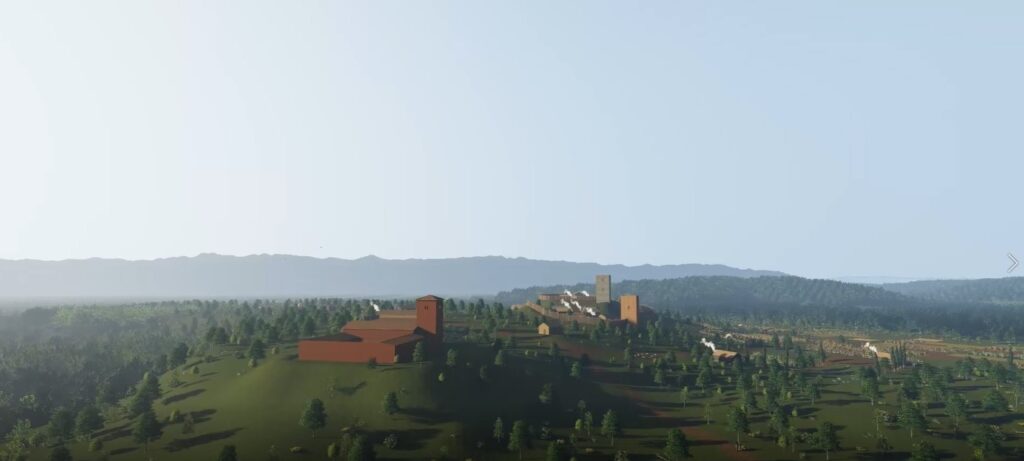
The castle was founded around the 10th century by count Lotario I, son of the forefather Cadolo, and it reached his maximum complexity in the 12th century, under the rule of count Ugolino III.
Archaeological research proves the presence of remains of the seigniorial residence in the lower part of the Torre Grossa of the 14th century Florentine Fortress. It was an imposing palatial tour located on the hilltop showing a building technique peculiar of city palaces in Lucca and Pistoia during the 10th century. At a lower altitude, archaeological excavations carried out in 1986 indicate the presence of wooden houses, covered by slate roof, belonging to a rural village.
The palace-tower and the village were surrounded and protected by wooden or masonry curtain walls.
At the time of count Ugolino, the Via Francigena passed between the castle and the hill of Salamarzana where vineyards, gardens and rural houses are documented. Shortly later the count donated the hill to the Vallombrosani monks in order to reconstruct the abbey of San Salvatore destroyed by a flood of the river Arno in 1106. On the same hilltop was already present the parish church founded in the late 11th century by count Ughiccione II, father of Ugolino.
At a lower altitude, along the Via Francigena, the grandfather of Ugolino, count Guglielmo, founded the hospital of Rosaia to assist the pilgrims.
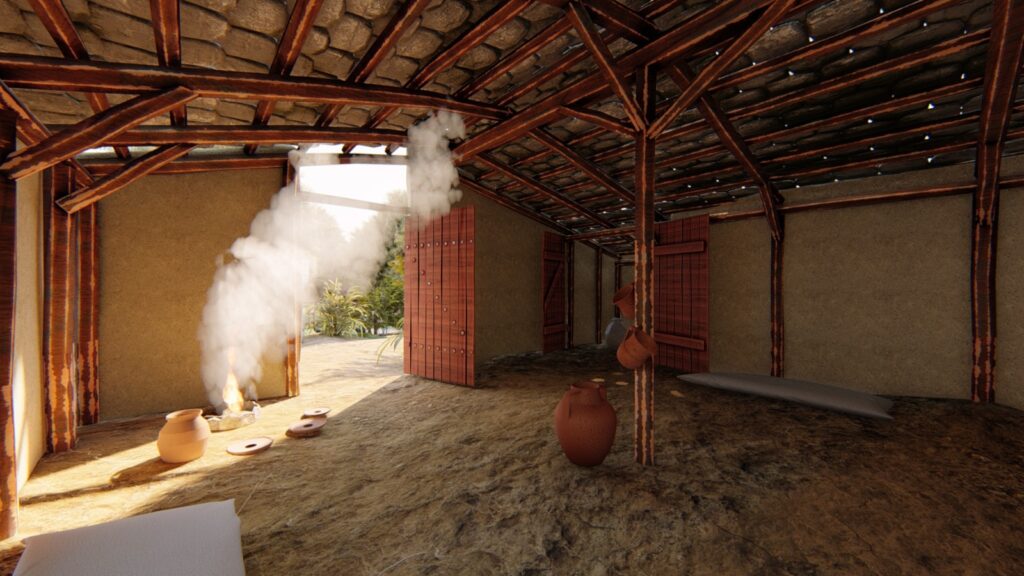
The house was discovered and excavated in 1984 on the Poggio Salamartano. It is a very rare example of a wooden and earthen medieval house, thanks to the formation of the archaeological deposit.
The house was destroyed by a sudden fire, most probably occurred in the late 12 century during one of the three military attacks, of 1136, 1161 and 1190, followed to the extinction of the Cadolingi family in 1113. The fire also affected the nearby abbey of San Salvatore which had to be rebuilt afterwards. Before these attacks, on the hilltop of Salamarzana there were vineyards and gardens and this rural house was certainly one among those reported by written sources.
The reconstruction of the interior of the house was possible thanks to the location of the objects on the floor preserved by the sudden collapse of the roof.
The house was built up on a clay platform and covered by a slate roof supported by wooden posts. Braiding frame walls, plastered with clay, defined a unique space. Three jars preserving grains were kept in a small storage room. An amphora for drinking water and two jugs were located beside the central post. The fireplace was located near the entrance. Straw beds were probably placed along the walls and a rudimentary pit latrine drained into the hill slope.
As to the diet of the inhabitants, a millstone indicates the domestic grinding of grains, while animal bones recovered from the floor prove the presence of poultry and sheep or goats.
.
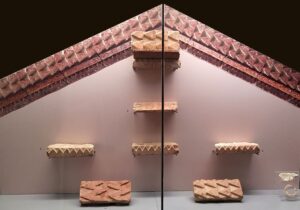
A church of San Salvatore, founded around 986 by the forefather Cadolo, preceded the abbey, founded by his son Lotario close to the village of Borgonuovo and the bridge on the river Arno. The abbey and the village were both destroyed by the flood of 1106 and count Ugolino donated the hill of Salamarzana to the abbot for the reconstruction. The new abbey underwent several destruction and subsequent reconstructions, due to the frequent wars in the aftermath of the extinction of the family of the Cadolingi.
The present church dates back to the late 12th or early 13th century.
The exhaustive collection of epigraphs referred to the counts of Fucecchio is here displayed in casts. The originals are scattered on a wide area, from the valleys of the Apennines Mountains between Bologna and Pistoia down to the countryside of Siena. Since most of them are nearly invisible, almost unknown and hard to read, a video helps reading these “inscribed stones” of the Cadolingi through high definition 3D virtual models and casts in actual size.
Five epigraphs report the names of six Cadolingians lived between the 10th and the 11th century, the apogee of the family in Tuscany: Cadolo, Lotario and Guglielmo, Adelasia, Gasdia and Cilla.
Cadolo quoted by the epigraph from the abbatial church of Sant’Antimo is probably the forefather of the family. His son, Lotario, altogether with his wife Adalasia, are mentioned on the problematic epigraph form Badi, on the Appennine, as parents of count Guglielmo. The latter is again inscribed on the bell tower of the Badia a Settimo, near Florence, the family abbey founded by count Lotario. The abbey was the burial place of the Cadolingian countesses Gasdia and Cilla, respectively wives of counts Guglielmo Bulgaro and Ughiccione. Despite the chronological incongruity, an old tradition says the portraits of count Lotario and his wife Adalasia are sculptured on a 13th century capital in the same abbey.

